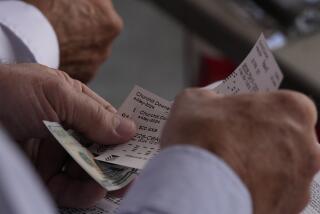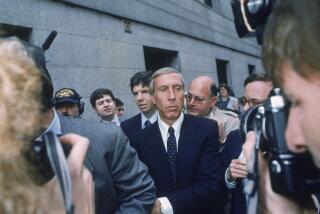âMerchants of Miseryâ : For Futures Markets, a Shady Past
The wild world of commodity futures trading has had a sullied reputation among consumers and lawmakers for decades, in part because of cases like Robert Hockerâs.
Hocker told a federal court in Wyoming that he didnât even know what a commodity was when a broker for First Commodity Corp. of Boston phoned him in 1983, when he was unemployed as an oil field worker.
Enticed by the brokerâs promise of huge profits in silver futures with little risk, Hocker invested more than $55,000--money he would never see again. First Commodity took about 40% of his money in fees the first day, then lost most of the rest. Hocker eventually got back $1,387.64.
High-Pressure Tactics
Hockerâs case illustrates a type of abuse that is all too common in commodities. Dozens of salesmen and commodity firms--including First Commodity--have been charged in recent years with using misleading or high-pressure tactics to lure unsophisticated investors into high-risk futures investments, tarnishing the image of commodities trading.
But this weekâs disclosure that the FBI has uncovered evidence of widespread improprieties among brokers and traders at the nationâs two largest futures exchanges involves a new and equally troubling dimension: Trading practices on the floor of commodities exchanges may be as corrupt and harmful to investors as practices in commodity brokersâ sales offices in communities throughout the country.
The FBIâs investigation--which centers on illegal collusion, false reporting of trades and other practices to skim investorsâ profits--could lead to reforms and increased regulation of the fast-growing world of futures trading. It also raises questions about the ethics within financial markets, where investors are often easy targets for savvy operators.
âThis looks very much like a mirror image of the abuses we are finding on the stock market,â says Scott Stapf, director of investor education for the North American Securities Administrators Assn., composed of state regulators who often investigate questionable sales practices by commodities brokerages.
But in many ways the latest allegations of improprieties should come as no surprise. Since their inception in the late 1800s, U.S. commodity markets have been targets of criticism--although not all of it fair. Even before the turn of the century, reformers were calling futures traders âmerchants of miseryâ because of alleged market manipulation.
Exchange officials and other market proponents say such characterizations are unfair and that commodities markets are no worse than the stock market or any other market where items are traded. Few cases of manipulation or price rigging have been proven in court, they add.
But the negative images persist, in part because commodities trading is so complicated, fast paced and little understood by the public.
A futures contract is an agreement between two parties for the delivery of a certain amount of a commodity at a specific future date. Futures markets originally were created so that farmers could guarantee a predetermined future price for their wheat, corn or other crops, thus âhedgingâ their risks against unpredictable price fluctuations that could wipe them out.
But right after the creation of the commodities markets, farmers and others were blaming lower crop prices on what they viewed as manipulation of the futures markets to drive down prices.
As early as 1876, seven traders on the Chicago Board of Trade went to jail after the Illinois Legislature enacted a short-lived law that declared futures trading to be illegal gambling, Robert Tamarkin, a futures market historian, notes in his book, âThe New Gatsbys: Fortunes and Misfortunes of Commodity Traders.â
By the late 1880s, approximately 200 bills had been introduced into Congress to kill all futures trading or trading in specific commodities, Tamarkin said.
In 1958, Congress actually banned the trading of onion futures on the Chicago Mercantile Exchange amid charges that excess speculation had driven prices so low that the bags in which onions were traded were worth more than the onions themselves, Tamarkin said.
Later, in 1970, the Chicago Merc suspended a group of traders for two or three years for allegedly trying to corner the pork belly market.
In 1978, farmers blaming depressed farm prices on futures markets drove tractors down LaSalle Street in downtown Chicago to the Chicago Board of Trade in protest. In 1985, angry farmers picketed both the Board of Trade and the Merc.
One of the biggest cases of alleged manipulation of futures markets involves the once-billionaire Hunt brothers of Texas. The Commodity Futures Trading Commission, which regulates the futures exchanges, charged the Hunts in a civil suit with trying to rig prices in silver between the fall of 1979 and March, 1980, when the metalâs price rose from $9 an ounce to $50, only to subsequently collapse.
Hunts Lose Suit
The Commodity Futures Trading Commission case against them is pending, but the Hunts last year were ordered to pay $132 million in a separate civil case after being found guilty of cornering the silver market.
Futures markets have also been accused of contributing to the October, 1987, stock market crash. Critics contended that speculators and others trading at the Chicago Merc in futures on the Standard & Poorâs 500-stock index drove down the expected future value of that index so low as to prompt investors trading in actual stocks at the New York Stock Exchange to unload their holdings.
In fact, many futures experts say, large traders with huge positions can in theory manipulate the markets--for at least a short while. Such manipulation is hard to sustain for long periods, however, because, if prices get too far out of whack with supply-and-demand conditions, other traders will profit from the discrepancies and push prices back to where they should be, said David Shimko, an assistant finance professor at USC.
But manipulation is not the only area of abuse. Investors often have used futures markets to evade or reduce income taxes. Through trading techniques called âstraddles,â these investors create losses and offsetting gains in commodities trading, but report the losses first to reduce current taxes. However, the Internal Revenue Service has become more sophisticated in recent years in detecting such transactions, and a crackdown appears to have reduced the practice.
Many swindlers have turned to commodities trading outside of the major exchanges. Among the most celebrated cases of such schemes was that involving Anthony De Angelis, a New Jersey man convicted in 1965 in a $100-million-plus swindle in which he sold nonexistent salad oil to unsuspecting investors.
Trader Fled to Europe
Perhaps the biggest alleged commodities swindler of all time is Marc Rich, who amassed a fortune at one time estimated to be close to $1 billion, largely through bogus trading of sugar, aluminum, sulfur, oil and other commodities. With 51 separate criminal charges filed against him--enough to put him in prison for 325 years--Rich fled the United States to Switzerland in 1983 and since has avoided efforts to extradite him.
Arguably the largest and fastest-growing type of commodities fraud involves telephone sales pitches of the type used by First Commodity Corp. of Boston. Earlier this week, as part of what authorities called the largest investigation of its kind, federal charges were filed against 18 former employees of First Commodity, alleging that they defrauded more than 2,600 investors of $23 million. The defendants are charged with using high-pressure sales tactics to persuade customers to invest in high-risk commodity ventures that they misrepresented as low risk.
Similar âboiler roomâ operations--typically fly-by-night sales outfits using fast-talking salesmen with prearranged scripts and phone lists--are particularly rampant in Orange and Los Angeles counties. Investigators have called Orange County the nationâs âboiler room capital,â as the regionâs nice weather and other amenities attract salesmen, often pitching bogus gold and precious metals investments.
âBoiler Roomâ Frauds
Typical of the type of âboiler roomâ frauds operating in Orange County was that run by Michael Maddox of San Clemente through his firm, Goldex International. Maddox last May pleaded guilty to five counts of mail and wire fraud in connection with using high-pressure sales tactics to lure unsophisticated investors into giving Goldex cash and valuables in exchange for investments in silver, gold and other metals that were never made.
But now, the FBIâs probe of trading at the Chicago Board of Trade and the Chicago Mercantile Exchange places a spotlight on potentially fraudulent trading practices on the floors of the major futures exchanges.
Such trading-floor abuses are not new but have not received the publicity of abuses off the exchange floors, in part because, until now, the cases have been isolated and involved small amounts.
An example of such a case involved trader Thompson B. Sanders. He was sentenced last November to six years in jail for masterminding a scheme in which a confederate wore a wig and false ID badge in the Board of Tradeâs Treasury bond pit. Sanders and five others used the disguises to duck out on unprofitable trades; they made $30,000 on profitable ones.
Exchange experts say the markets--although carefully supervised by the exchanges themselves--are susceptible to such abuses.
The exchangesâ âopen outcryâ system of trading, in which traders use hand signals and shouts to trade with one another in a recessed area called a âpit,â often leads to mistakes that on busy days could affect as much as 3% of all trades, USC assistant finance professor Shimko said.
Critics contend that rules allowing floor brokers to trade for themselves as well for clients create the potential for conflicts. A broker, for example, may allocate losing trades to customers and keep winning trades for himself.
Critics contend also that the Commodity Futures Trading Commission is too understaffed to adequately oversee the markets, which have grown phenomenally since the agency was created in 1975 and have expanded into new areas such as Treasury securities and foreign currencies.
But exchange officials and other market proponents say commodities trading has gotten what amounts to a bum rap.
The exchanges, in attempts to attract even more investors, generally do a good job of monitoring trading and have been tough when they find wrongdoing, proponents say. For example, in 1987, to counter allegations that some brokers had failed to give customers the best price for a contract, the Merc reserved the top step of its S&P; 500 stock-index futures trading pit for members who executed orders for others but did not trade for their own accounts. The move gives those traders the most visibility in a crowded trading pit.
And Thursday, the Merc announced that it had imposed a $750,000 fine--its largest ever--on a husband-and-wife trading team who had âprearrangedâ trades. The Merc did not provide further details of the infractions by the couple, Barry and Carlem Haigh, who were also expelled from the exchange.
Although allegations of large-scale market manipulation are common, most have never been proven, Merton Miller, a finance professor at the University of Chicagoâs graduate school of business, contends. âIf you look at the historical record, only a half dozen cases have been tried in court, and the Hunt case isnât over yet,â Miller said. And, although there are some bad apples, the overwhelming majority of trades and traders are legitimate and honest, Miller said.
More to Read
Inside the business of entertainment
The Wide Shot brings you news, analysis and insights on everything from streaming wars to production â and what it all means for the future.
You may occasionally receive promotional content from the Los Angeles Times.










